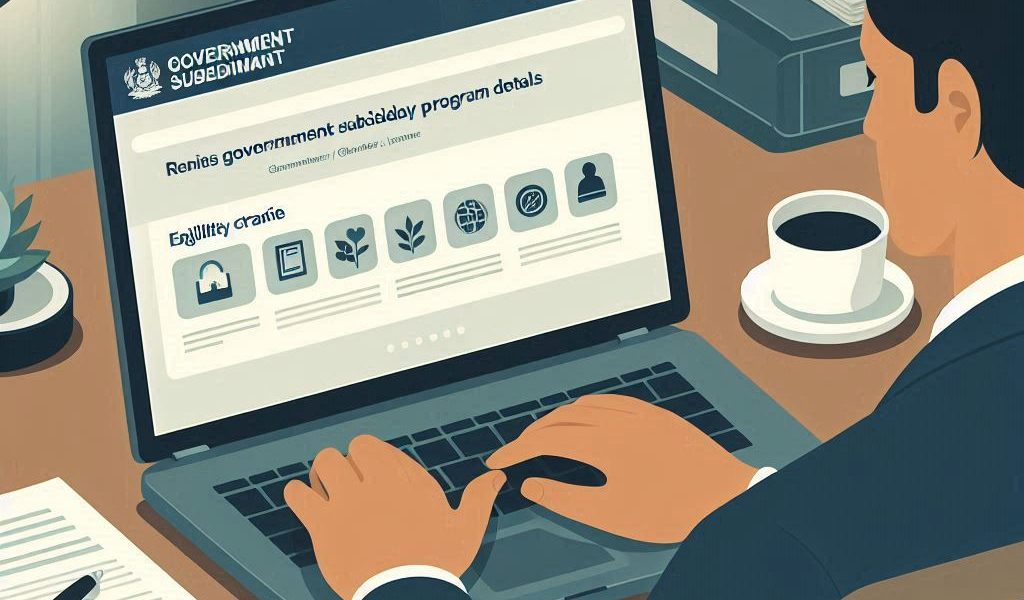Government subsidies are an excellent way for businesses and individuals to receive financial assistance for various purposes, from starting a business to supporting education or making environmental improvements. However, before applying for any subsidy, it’s essential to determine if you are eligible. Understanding the eligibility criteria ensures that your application is successful and reduces the chances of wasting time or resources on an unsuitable subsidy.
In this blog, we will guide you through the step-by-step process of checking your eligibility for government subsidy programs, explore the common eligibility requirements, and provide tips for a successful application. Whether you’re a small business owner, farmer, student, or anyone interested in receiving government aid, this guide will help you navigate the complexities of government subsidy programs.
What Are Government Subsidy Programs?
A government subsidy is a financial assistance program provided by the government to individuals or organizations to support specific activities, such as education, healthcare, research, agriculture, housing, or environmental sustainability. These subsidies can take the form of direct cash payments, grants, tax breaks, or low-interest loans.
Government subsidies help reduce the financial burden on the recipient and encourage initiatives that contribute to the public good, such as fostering economic growth, environmental conservation, or increasing access to essential services.
Why Should You Check Your Eligibility?
Eligibility is the first and most critical step in the subsidy application process. By confirming that you meet the criteria set forth by the program, you ensure that your application will be considered. If you apply for a subsidy without meeting the eligibility requirements, your application could be rejected, and you may not receive the necessary funding or support.
Checking your eligibility ahead of time also allows you to gather the correct documentation and make any necessary adjustments to your business or personal circumstances to better align with the subsidy program’s requirements.
Step-by-Step Guide: How to Check Your Eligibility for Government Subsidy Programs
Before you apply for a government subsidy program, follow these steps to ensure you’re eligible and prepared for the application process:
1. Identify the Right Subsidy Program for You
The first step is to identify which government subsidy program best fits your needs. Subsidy programs vary widely depending on the country, region, and type of support you’re seeking. Programs may exist for sectors such as agriculture, business development, renewable energy, education, healthcare, housing, or disaster recovery.
Here’s how you can identify the right program for your needs:
- Visit Government Websites: Most government agencies maintain detailed websites listing all available subsidies and funding programs. Look for sections dedicated to grants, loans, or financial assistance.
- Consult Industry Associations: Many industries, such as agriculture or technology, have associations that provide information on available government subsidies tailored to specific fields.
- Use Subsidy Search Tools: Several government and private organizations offer tools or online databases where you can search for subsidies based on your location, business type, or purpose.
2. Review the Eligibility Criteria
Once you’ve identified a subsidy program, the next step is to carefully review the eligibility requirements. Each government subsidy program will have its own set of criteria that applicants must meet in order to qualify for financial assistance.
Common Eligibility Criteria to Check Include:
- Business Size: Some subsidy programs are intended for small and medium-sized businesses (SMEs), while others may be for large corporations or specific sectors.
- Location: Many subsidies are available only to businesses or individuals in specific regions or countries. Be sure to check the geographical requirements.
- Industry Type: Certain subsidies are targeted to specific industries, such as renewable energy, technology, agriculture, or education.
- Financial Health: Some programs may require businesses to demonstrate financial stability or a certain level of revenue or income.
- Environmental or Social Impact: If the subsidy is for sustainable or socially responsible projects, you may need to show how your business or project aligns with environmental or social goals.
- Demographic Criteria: Some subsidies are intended for specific demographic groups, such as women entrepreneurs, veterans, or low-income households.
3. Gather Required Documents
Once you’ve reviewed the eligibility criteria and confirmed that you meet the requirements, gather all the necessary documentation to support your application. Having the correct paperwork ready is crucial for a smooth application process.
Common documents you may need include:
- Identification: Proof of identity such as a passport, national ID card, or driver’s license.
- Financial Records: Recent tax returns, profit-and-loss statements, balance sheets, or business bank statements.
- Business Plan or Project Proposal: A detailed description of the business or project you are seeking funding for, including its goals, target market, and expected outcomes.
- Legal Documentation: Documents related to the legal status of your business, such as articles of incorporation, partnership agreements, or proof of business registration.
- Supporting Statements or Certifications: Any certifications related to environmental sustainability, diversity, or innovation that may be relevant to the subsidy program.
4. Consult with Subsidy Experts or Advisors
If you’re unsure about your eligibility or have questions about the application process, consider seeking professional advice. Many government agencies, non-profit organizations, and consulting firms specialize in helping businesses and individuals navigate the subsidy process.
Subsidy experts or advisors can provide valuable insights into:
- Understanding the Complexities: They can help explain complex eligibility criteria and guide you through the paperwork.
- Maximizing Your Chances of Success: Advisors may assist you in crafting a compelling application or business plan that meets the subsidy requirements.
- Finding Additional Opportunities: Experts can help you identify additional funding sources or subsidy programs that might be a good fit for your needs.
5. Use Eligibility Checkers and Online Tools
Some government websites and third-party platforms provide online eligibility checkers that can help you quickly determine if you meet the requirements for a subsidy. These tools typically involve answering a series of questions about your business, project, or personal situation.
If an eligibility checker is available, use it to get an initial assessment of your eligibility before submitting a full application. This can save you time and help you focus on the most appropriate subsidy programs.
Key Tips to Improve Your Eligibility
While some eligibility criteria may be out of your control, there are a few strategies that may increase your chances of qualifying for government subsidies:
1. Align with Government Priorities
Government subsidies are often aligned with broader national priorities, such as sustainability, innovation, or economic growth. If your business or project aligns with these priorities, you may have a better chance of qualifying for funding.
2. Improve Financial Stability
If the subsidy program requires businesses to show financial health, ensure your business has up-to-date financial statements and a solid record of profitability or growth. Work with a financial advisor to ensure your financial records are in good shape.
3. Demonstrate Social or Environmental Impact
Many subsidies, especially those related to green business or social impact, favor applicants who can show measurable benefits to society or the environment. Make sure to highlight the positive impact of your business or project in your application.
4. Stay Informed About New Programs
Government subsidy programs may change over time, with new ones being introduced and others being phased out. Stay updated on new subsidy programs and opportunities to increase your chances of receiving funding.
Conclusion: Navigating Government Subsidy Programs
Checking your eligibility for government subsidy programs is a critical step to ensure you receive the financial support needed for your business or personal goals. By following the steps outlined in this blog, you can systematically review available programs, understand the requirements, gather the necessary documentation, and increase your chances of receiving the funding you need.
Remember, eligibility is not the only factor that determines success; a well-prepared application, a clear understanding of the subsidy’s goals, and effective communication of your project or business’s benefits will help strengthen your application.
With the right guidance and preparation, you can confidently navigate the subsidy process and unlock valuable government funding opportunities to support your growth, sustainability, or innovation.




